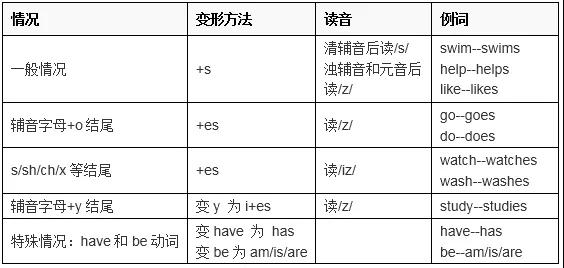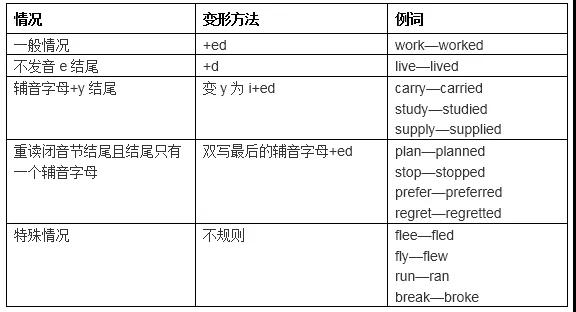一起来看看中考考试栏目小编为您整理的“2019年中考英语时态介绍<上>”吧,也许可以给您的考试带来一点帮助!本网会及时的更新中考考试的最新资讯,敬请关注!
2019年中考英语时态:一般现在时
标志:动词原形

1. 表示经常性或习惯性动作,常与表频度的时间状语连用:
She often speaks English.
I leave home for school at 7 every morning.
2. 表示现在的状态、特征、职业、能力、感觉等:
He seems to feel a bit down today.
He works as a driver.
3. 表示真理、客观存在、科学事实或用于格言警句中:
Shanghai lies in the east of China.
Columbus proved that the earth is round.
Where there is a will, there is a way.
4. 表示现在瞬间的动作:
Here comes the bus!
5. 表示将来
1) 表按规定、计划、安排将要发生的动作(仅限于某些表示“来、去、动、停、开始、结束、继续”等的趋向动词),可以与表示未来的时间状语搭配使用。常见的用法是:飞机、火车、轮船、汽车等定期定点运行的交通状况。如:
The next train leaves at 3 o’clock this afternoon.
How often does the shuttle bus run?
2) 在时间和条件状语从句中常使用一般现在时表示将来发生的事情:
When Bill comes (不用will come), ask him to wait for me.
I shall go there tomorrow unless I’m too busy.
2019年中考英语时态:一般过去时
标志:动词过去式

*闭音节:元音字母a, e, i, o, u如果发字母本来的音则称为开音节,否则称为闭音节。
1. 表示过去某时所发生的动作或存在的状态,常与表示过去的时间状语连用(e.g. yesterday, this morning, just now, a moment ago, in May, last night / year / week, once upon a time, the other day, before …, when …, in the past等)。如:
Jim rang you just now.
Liu Ying was in America last year.
2. 表示过去经常或反复发生的动作,特别是used to do表达的句型,本身表示的就是过去常常。如:
When I was a kid, I often played football in the street.
She used to visit her mother once a week.
*注意区分sb. used to do sth.(某人过去常常做某事,此处to是动词不定式标志符号)和sb. be used to sth./doing sth.(某人习惯于某物/做某事,此处to是介词)。
3. 代替一般现在时,表示一种婉转、客气、礼貌、商量的语气。此用法仅适用于少数动词(如want, hope, wonder, think, intend等)及情态动词could, would。如:
I wondered if you could have a word with me.
I hoped you could help me with my English.
Would you mind my sitting here?
4. 虚拟语气中用一般过去时表示现在或将来时间的动作或状态。常用句型有:
It is time that sb. did sth. “某人该做某事了”
would rather sb. did sth. “宁愿某人做某事”
2019年中考英语时态:一般将来时
标志:will / shall + 动词原形
1. 表示将来发生的动作或存在的状态,通常与表示将来的时间状语连用(e.g. tomorrow, next week, in the future等)。如:
We shall have a lot of rain next month.
My husband will come back in a few days.
2. 表示倾向性和习惯性:
Fish will die without water.
When it gets warmer, the snow will start to melt.
3. 一般将来时的几种句式结构辨析:
1) will / shall + 动词原形
多用于表达主观愿望或必定会发生的事情(“将会如何”)
*shall作助动词时一般只用于第一人称
2) be going to + 动词原形
表示即将发生或打算要做的事:
It is going to rain.
We are going to have a meeting today.
3) be to + 动词原形
表示按计划或安排即将要发生的动作:
He is to visit Japan next year.
We are to discuss the report on Monday.
4) be about to + 动词原形
表示即将发生的动作,意为“马上要做某事”,后面一般不跟时间状语,如:
The plane is about to start.
Don’t worry. I am about to make a close examination on you.
2019年中考英语时态:现在进行时
标志:be + 动词的现在分词
1. 表示说话时正在进行的动作:
She is writing a letter upstairs.
Who are you waiting for?
It is raining hard.
2. 表示现阶段一直在进行的动作(说话时动作未必正在进行):
I hear Mr. Green is writing another novel.
3. 表示反复出现或习惯性的动作,往往包含说话者赞扬、责备、厌恶等情绪,通常与always, constantly, continually, forever等频度副词连用。如:
John is forever asking silly questions like a stupid.
He is always thinking of others first.
4. 表示将来
1) 表示按计划、安排将要发生的动作,仅适用于部分趋向动词(如go, come, leave, start, arrive等)。如:
Uncle Wang is coming.
They're leaving for Beijing.
2) 在时间和条件状语从句中,现在进行时表示将来某时正在发生的事情。如:
Please drop in when you are passing my way.
If he is still sleeping, don’t wake him up.
推荐阅读:
| 中考政策 | 中考状元 | 中考饮食 | 中考备考辅导 | 中考复习资料 |


